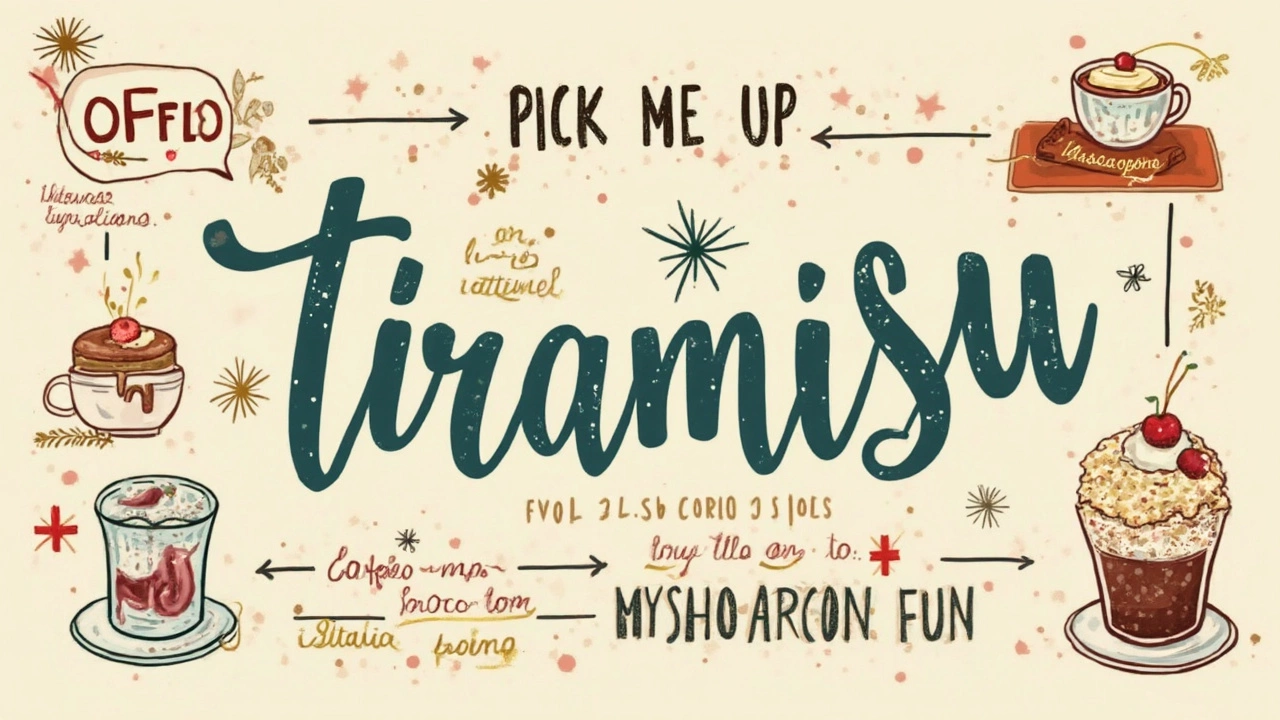
Ever heard someone say tiramisù and wondered if it’s just a fancy Italian name, or if it actually means something? Believe it or not, 'tiramisù' is more than just a dessert—it’s a legit Italian phrase. You know how kids sometimes ask questions that seem obvious, but end up making adults realize they have no idea? Clara hit me with this one over dinner last week. Turns out, it’s worth a closer look.
The first thing to know: 'tiramisù' literally comes from the Italian phrase “tira mi sù,” which means “pick me up.” Sounds straightforward, right? But there’s a good reason why this dessert got that name—it’s not only about the sugar rush. Knowing what tiramisù means can actually help you understand why Italians love this treat so much and how it fits into their culture.
- Cracking the Name: What Does Tiramisù Mean?
- How Italians Came Up With It
- Literal Translation vs. Real-World Use
- The Dessert’s History in a Nutshell
- Fun Facts and Common Myths
- How to Pronounce and Use the Word
Cracking the Name: What Does Tiramisù Mean?
If you break down the word tiramisù, you get three Italian parts: "tira" (pull), "mi" (me), and "sù" (up). Put together, it literally means "pick me up" or "lift me up." That’s not just a funny coincidence. This name actually hints at what the dessert is supposed to do—cheer you up, give you an energy boost, and generally make you feel better. After all, we’re talking about a dessert loaded with espresso and sugar.
The phrase started popping up in Italian kitchens and coffee shops in the late 20th century. Before tiramisù became the international superstar it is today, Italians already used the phrase "tirami su" as a way of saying something would perk them up, either with food or good company.
Why did it stick as the name for this dessert? Simple: a slice of this layered treat is pretty much a sweet wake-up call. The combination of espresso, creamy mascarpone, and a touch of cocoa packs a punch, especially after a big meal (or a long day). That’s exactly what the name is about—no wild legends, just a straightforward description from the inventors themselves.
| Word | Italian Meaning | English Translation |
|---|---|---|
| Tira | Pull | Pick |
| Mi | Me (myself) | Me |
| Sù | Up | Up |
So, if you ever want to impress someone with your dessert trivia, you can say that tiramisù is basically Italian for "cheer me up!"—and it delivers on that promise, one creamy spoonful at a time.
How Italians Came Up With It
Italians didn’t just randomly slap a name on this dessert. The story behind tiramisù’s naming is actually tied to how the dessert made people feel. The original idea was that a serving of tiramisù gave you an energy boost. Back in the 1960s and ’70s, people in Northern Italy, especially the Veneto and Friuli Venezia Giulia regions, started layering together ladyfingers, espresso, mascarpone, eggs, and cocoa. These were all things that could perk you up—no mystery there.
The most likely birthplace? Treviso, near Venice. At a small restaurant called Le Beccherie, chef Roberto Linguanotto and his apprentice Francesca Valori are usually credited with creating the first official tiramisù around 1969. Francesca’s maiden name was actually Tiramisu, so how’s that for a coincidence?
So why “pick me up”? Here’s the breakdown of the Italian: “Tira” means pull, “mi” means me, and “su” means up. Pull me up, or pick me up—get it? This ties right back to the dessert’s reputation as a quick pick-me-up, thanks to the mix of sugar, espresso, and sometimes even a hint of liqueur.
- Coffee for a caffeine kick
- Sweet mascarpone and sugar for instant energy
- Ladyfingers to soak it all up
It didn’t take long for tiramisù to become popular, both in Italy and around the world. It’s one of Italy’s most googled desserts. Check out these numbers people in Italy search for tiramisù recipes every month:
| Year | Google Searches (Italy, per month) |
|---|---|
| 2021 | 70,000+ |
| 2022 | 88,000+ |
| 2023 | 110,000+ |
The love for tiramisù is strong, and it all goes back to how it got both its name and its reputation as a mood booster.
Literal Translation vs. Real-World Use
So, let's break down what 'tiramisù' really means word for word. In Italian, 'tirami' comes from 'tirare,' meaning 'pull,' and 'sù' means 'up.' Together, it’s 'pick me up.' This isn’t just a cute phrase—it actually tells you something about the dessert. The original idea? Tiramisu is supposed to lift your spirits, thanks to its combo of coffee, sugar, and creamy mascarpone cheese.
But does everyone in Italy stop and think about the meaning before diving in? Not really. 'Tiramisù' is now pretty much just the name for that famous dessert. You’ll hear it at every café or dinner table, and Italians rarely use it in any other context. If you say 'tiramisù' anywhere in Italy, nobody thinks you’re talking about someone literally picking you up—they just want to know if you brought dessert.
Take a look at how often this word shows up in different ways. Here’s a quick breakdown based on common usage:
| Phrase | Literal Meaning | Real-World Usage |
|---|---|---|
| Tiramisù (the dessert) | Pick me up | The actual dessert we all love |
| Tirami su! (spoken phrase) | Pick me up! | Only said if you want someone to literally lift you up – pretty rare! |
Here's the thing: the literal meaning—'pick me up'—is fun to know, but in the wild, tiramisù almost always points to that layered, coffee-soaked treat. Italians don’t mix up the two, and if you ask for tiramisù, you should be ready for dessert, not a piggyback ride.
If you want to sound extra in-the-know, you can drop the translation in conversation. But don’t expect anyone in Rome or Venice to giggle at the name—they’re just proud of their national dessert!

The Dessert’s History in a Nutshell
If you think tiramisù has been around for centuries like some ancient Italian recipes, you might be surprised. This creamy, coffee-soaked treat actually popped up in the 1960s, not in the Renaissance. Most stories point to the region of Veneto, in Northern Italy, as the spot where tiramisù was first whipped up. A restaurant called Le Beccherie in Treviso claims the bragging rights, and even put up a plaque out front. That’s confidence.
There’s still some debate about exactly who invented it, but almost every story dates tiramisù’s first appearance to somewhere between the late 1960s and early 1970s. One thing’s for sure: Italians didn’t eat it for dessert in their great-grandmother’s kitchens.
If you love random trivia, here’s a quick snapshot in table form:
| Year | Location | Fun Fact |
|---|---|---|
| 1969 | Treviso (Le Beccherie) | Restaurant owners claim they invented tiramisù recipe. |
| 1980s | Italy-wide | Tiramisù starts popping up all over Italian pastry shops. |
| 1985 | USA | The dessert hits American restaurants and becomes trendy. |
Another thing people often miss: classic tiramisù doesn’t have cream or liqueur, just mascarpone, eggs, sugar, espresso, ladyfingers, and cocoa powder. American versions started tweaking the recipe, but if you want it the old-school way, those basics are the heart of it.
So, next time someone wonders if tiramisù is an ancient Italian secret, you can tell them it’s way more modern than expected—and that’s part of its charm.
Fun Facts and Common Myths
It’s wild to see how many tall tales float around about tiramisù. Let’s bust some myths and toss in a few facts you’ll want to remember next time dessert comes up in conversation.
- It’s not a centuries-old tradition: People love to say tiramisù goes way back in Italian history, but most food historians agree it probably showed up in the 1960s. Yup, your dad might be older than tiramisù.
- Some stories claim tiramisù was served in brothels to "lift the spirits" of customers, but there’s no real proof. It’s just more fun than the real, less spicy origin in northern Italy.
- The original recipe didn’t have cream or whipped cream. Classic tiramisù uses only mascarpone, espresso, eggs, sugar, and ladyfingers. Leave the fancy ingredients for café versions made outside Italy.
- The actual birthplace is hotly debated. Most fingers point to Treviso, a city in the Veneto region, but some restaurants in Friuli claim they made it first. The truth? Italians still argue about it over lunch.
| Fact | Detail |
|---|---|
| Number of Calories (per 100g) | Around 240 |
| First Documented Recipe | Late 1960s, near Treviso |
| Traditional Alcohol | Marsala wine or none |
| Most Searched Term (Italy 2024) | Tiramisù recipe |
Here’s a tip if you want to spot real-deal tiramisù: look for coffee-soaked ladyfingers and mascarpone—no whipped cream, no chocolate chips, and absolutely no strawberries. And if someone tells you tiramisù means "heavenly delight" or something fancy, you know better now. The real tiramisù is simple, sweet, and just meant to pick you up—literally.
How to Pronounce and Use the Word
Saying tiramisù right isn’t just for people who want to sound Italian in fancy restaurants—it’s super helpful if you ever order it on vacation or chat about it with friends. The pronunciation is straightforward: "tee-rah-mee-SOO" (with the stress on the last syllable). The ‘ù’ at the end? In Italian, that accent pushes you to give the final 'oo' a stronger sound. Need a shortcut? Just say it like this: tee-rah-mee-SOO.
Here’s a quick table to make sure you nail it every time:
| Word | How to Say It | Accent Note |
|---|---|---|
| tiramisù | tee-rah-mee-SOO | Stress at the end (ù) |
Now, about using the word—tiramisù is usually a noun, just like ‘cake’ or ‘pie.’ So you’d say, “I’d like a slice of tiramisù, please.” Italians don’t add an 's' to make it plural—the word is the same, even if you’re ordering a dozen. Also, don’t call it ‘a tiramisùs’ or ‘tiramisus’—stick to the original, and you’ll sound like you know your stuff.
If you’re writing a menu or just texting a friend, lowercase is fine unless it’s at the beginning of a sentence. But no matter what, don’t use “tiramisù” for anything that’s not this specific dessert. In Italy, people know exactly what they’re getting: ladyfingers, coffee, mascarpone, cocoa, happiness. No surprises.
Little tip from someone who’s embarrassed herself speaking Italian: if you ever have to order more than one, just say “due tiramisù” (due means two). Bonus points if you do it with a grin.